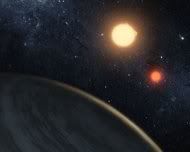
US astronomers said Thursday they have discovered the first planet that is orbiting two Suns, much like the fictional home of Luke Skywalker featured in Star Wars.
Skywalker's native planet of Tatooine was hot and desert-like, but this planet, called Kepler-16b, is a freezing cold world about the size of Saturn, orbiting two parent Suns in a near perfect circle about 200 light years away.
The planet was glimpsed with the US space agency's Kepler space telescope, which monitors the brightness of 155,000 stars, according to the research published in the journal Science.
"This discovery is stunning," said co-author Alan Boss of the Carnegie Institution for Science Department of Terrestrial Magnetism.
"Once again, what used to be science fiction has turned into reality."
While astronomers have previously glimpsed planets they believed were orbiting two stars, they had never before seen one actually passing in front of its two Suns so this discovery offers the first proof.
"Kepler-16b is the first confirmed, unambiguous example of a circumbinary planet -- a planet orbiting not one, but two stars," said co-author Josh Carter of the Harvard-Smithsonian Center for Astrophysics.
"Once again, we're finding that our solar system is only one example of the variety of planetary systems nature can create."
If there were people on Kepler-16b, they could relax to the view of a double sunset, but such a scenario is highly unlikely due to the planet's extreme frigid surface temperature of -100 to -150 Fahrenheit (-73 to -101 Celsius).
The chill is likely due to the fact that even though the planet has two Suns which it orbits every 229 days at a distance of 65 million miles (105 million kilometers), they are smaller and cooler than our single Sun.
One of Kepler-16b's Suns is 20 percent as massive as ours, and the other is 69 percent as massive.
While the planet orbits them, the two Suns dance with each other in an "eccentric 41-day orbit," the study said.
The study was led by Kepler scientist Laurance Doyle of the California-based SETI (Search for Extraterrestrial Intelligence) Institute.
AFP News – Fri, Sep 16, 2011


















